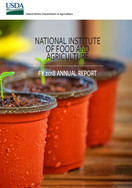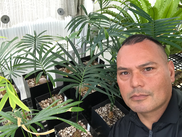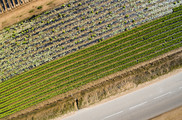|
Having trouble viewing this email? View it as a Web page.

|
|
|
Fresh From the Field is a weekly album showcasing transformative impacts made by partners supported by the National Institute of Food and Agriculture.
Editor: Falita Liles July 11, 2019
|
|
Success Stories

NIFA’s 2018 Annual Report Now Online
NIFA’s 2018 Annual Report has been published. This year’s report highlights the exciting work undertaken by NIFA-funded grantees in the areas of research, education, and extension.
As our director, J. Scott Angle, notes in his introduction, “This annual report includes powerful examples of the many NIFA-funded research, extension, and education solutions that address societal challenges. I look forward to the transformative and remarkable discoveries that our grantees will make. Read the full NIFA 2018 Annual Report.
|

Cycad Seeding Connections between Guam and the United States
Sometimes the fruit of decades of research manifests in unintended, but delightful, ways. Thomas Marler, a research scientist with the Western Pacific Tropical Research Center (WPTRC) at the University of Guam (UOG), has been studying Guam’s native cycad since the 1990s, long before it was subjected to the threats of non-native specialist insect pests. The accidental introduction of the Asian cycad scale to Guam has decimated the population of this once abundant tree. The uncontrolled tree mortality led to Cycas micronesica being listed as Threatened under the Endangered Species Act in 2015.
Marler has coordinated seed exchanges and cycad research with the Montgomery Botanical Center (MBC) in Miami, Florida, since 1997. The extensive population of cycad trees at MBC is comprised of plants derived from seeds that Marler originally contributed in 1997 and 1998. Marler in 2006 started a germplasm collection of fadang, the seed of the false sago palm (a cycad), on the neighboring island of Tinian. These expansive seed collection efforts, along with that of the Nong Nooch Tropical Botanical Garden in Thailand, helped expand the fadang germplasm collections.
For more information about WPTRC research scientists and activities, please visit www.uog.edu/wptrc.
|
News Coverage

When Do Cover Crops Pay? New SARE Report Addresses the Question
Farmers around the country are planting cover crops on millions of acres to protect and improve the soil, and the more that farmers use cover crops, the more they value this conservation practice. Cover Crop Economics, a new report published by the USDA Sustainable Agriculture Research and Education (SARE) program, looks at the economics of cover crops to help farmers answer that big question: "When do cover crops pay?"
The key, says North Dakota farmer Justin Zahradka, who has been planting cover crops since 2011, is to “look at cover crops as an investment rather than a cost.”
Based primarily on yield and economic data gathered through five years of national cover crop surveys, the report addresses the economic returns that can be expected from cover crops, both under various management scenarios and as cover crops improve soil health over time. The report is timely, as the latest Census of Agriculture revealed that national cover crop acreage increased by 50 percent from 2012 to 2017. It’s also timely due to the interest in cover crops for planting on fields that were flooded or otherwise unplanted this spring. The report finds that planting a cover crop as a livestock grazing opportunity is one of the fastest avenues to profitability.
Read more at Cover Crop Economics.
|
Library

Growing Together
Growing Together is a multi-state SNAP-Ed project to increase access to fruits and vegetables in food pantries. SNAP-Ed, the Master Gardener Program, and food pantries are working together to build and maintain donation gardens in their communities.
Read the 2018 SNAP-Ed Highlights that connect Iowa State University, Purdue University, University of Illinois, University of Nebraska, and the University of Wisconsin.
|
Tweet of the Week
#NIFAIMPACTS

|
|

NIFA’s mission is to invest in and advance agricultural research, education, and extension that solve societal challenges. NIFA’s investments in transformative science directly support the long-term prosperity and global preeminence of U.S. agriculture. To learn more about NIFA’s impact on agricultural sciences, visit www.nifa.usda.gov/Impacts, sign up for email updates or follow us on Twitter @USDA_NIFA, #NIFAImpacts.
USDA is an equal opportunity lender, provider, and employer.
|
|